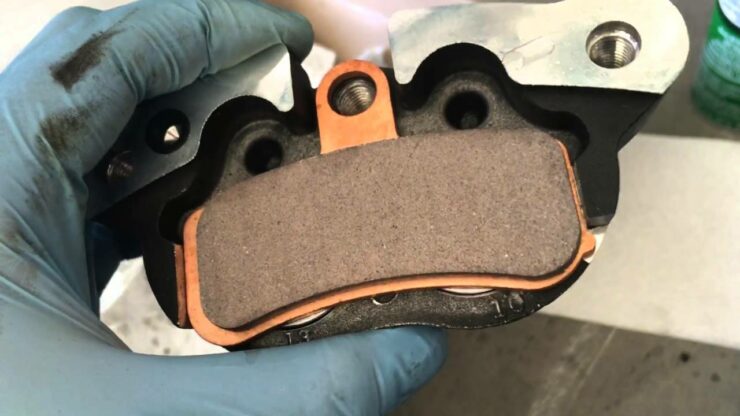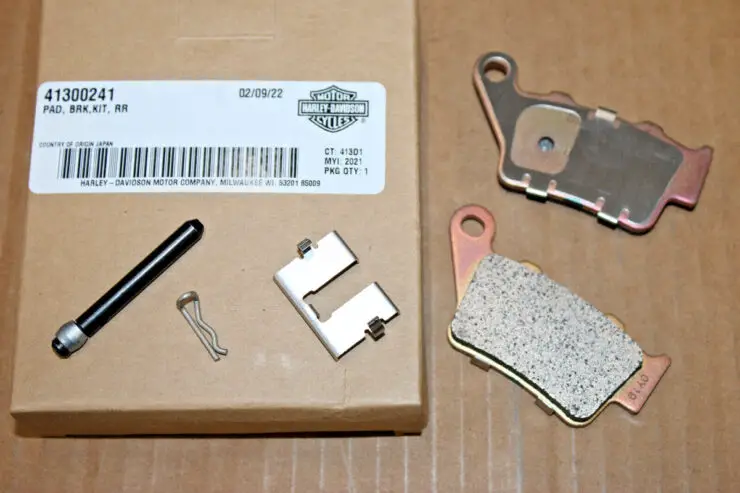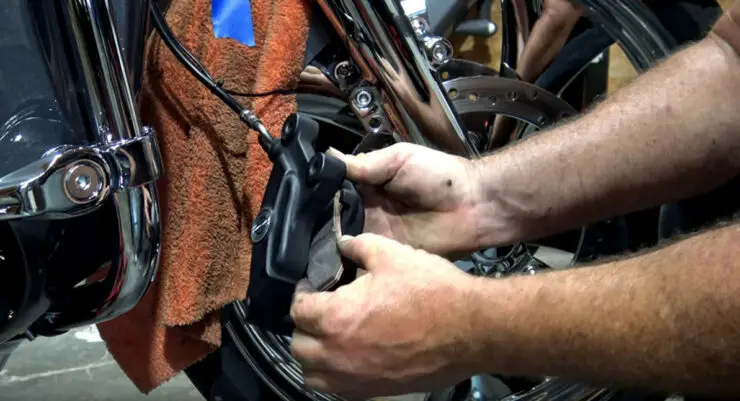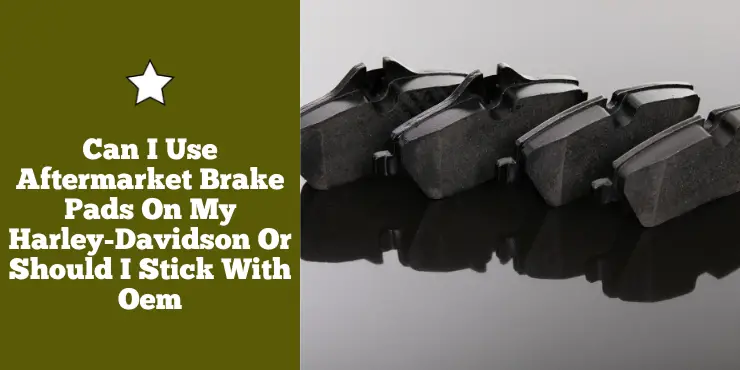Are you a proud owner of a Harley-Davidson motorcycle? Are you torn between the decision of whether to use aftermarket brake pads or stick with the original equipment manufacturer (OEM) ones?
You can use aftermarket brake pads, but ensure they’re high quality and compatible with your Harley model. OEM pads ensure fit and performance, but reputable aftermarket options can offer similar or better performance.
Well, in this article, we’ll dive into the world of Harley-Davidson brake pads and help you make an informed choice. While there are benefits to both options, it’s important to consider factors such as performance, cost, and compatibility. So, buckle up, and let’s explore whether aftermarket brake pads can match up to the quality and reliability of OEM ones for your beloved Harley-Davidson.
Different components in the braking system
When talking about legendary motorcycles, Harley-Davidson is a name that stands out as an iconic brand that has continued to captivate bikers for a long time. One of the most important parts of the Harley-Davidson riding experience is its performance. That controlled, silky smooth performance is possible in large part thanks to the braking system. Here are the different components of the braking system in a Harley-Davidson motorcycle.
>>> Click here to read our review of the Best Break Pads For Harley-Davidson <<<
#1. Brake discs
At the heart of the Harley-Davidson bike’s braking system will be the brake discs, commonly referred to as rotors. These large, metal discs will be mounted directly on the bike’s wheels. They serve as the surface on which the brake pads clamp down for generating the needed friction for slowing down or stopping the motorcycle. Harley-Davidson often uses dual-disc setups on larger and more powerful models to enhance braking performance.
#2. Brake calipers
The brake calipers are known for squeezing the brake pads against the brake discs. Harley-Davidson bikes tend to employ a twin-piston or four-piston caliper design. The more pistons the caliper has, the more evenly the force will be distributed, resulting in better braking performance. Harley’s use of high-quality calipers ensures a strong and responsive braking system, contributing to rider safety.
#3. Brake pads
Brake pads are important components of the braking system that create friction when they press up against the brake discs. These pads are made using composite materials designed to withstand the heat and pressure generated during braking. They are carefully engineered for providing excellent stopping power while maintaining longevity.
#4. Master cylinder
The master cylinder is responsible for transmitting the force applied to the brake lever by the rider to the brake calipers. These bikes typically use a hydraulic master cylinder, which ensures a consistent and reliable transfer of force, resulting in precise braking control. The master cylinder contains a reservoir for brake fluid, which is important for maintaining the hydraulic system’s efficiency.
#5. Brake lines and hoses
The brake lines and hoses play a key role in transmitting hydraulic fluid from the master cylinder to the brake calipers. These components are constructed using durable, high-quality materials to withstand the pressure and temperature changes that occur during braking. Harley-Davidson motorcycles are equipped with well-engineered brake lines and hoses to ensure the integrity of the hydraulic system.

#6. Brake fluid
Brake fluid is the lifeblood of the braking system. Harley-Davidson bikes typically use DOT 4 or DOT 5 brake fluids, which have high boiling points and excellent moisture resistance. Regular maintenance, including brake fluid replacement, will be important to ensure the braking system’s optimal performance and safety.
#7. ABS (Anti-Lock Braking System)
Many modern Harley-Davidson bikes come equipped with an Anti-Lock Braking System. The ABS is a safety feature responsible for preventing wheel lockup during hard braking, allowing the rider to maintain control of the bike. ABS sensors monitor wheel speed and apply and release the brakes rapidly for preventing skidding. This is especially valuable in adverse weather conditions or emergency stops.
What is the role of brake pads in Harley-Davidson motorcycles
For Harley-Davidson riders, the experience of riding one of these bikes is often described as exhilarating, powerful, and liberating. However, the exhilaration can end up turning into danger quickly if you do not have a reliable braking system. A reliable braking system is not just an accessory. It is the lynchpin of rider safety.
The ability to control your bike’s speed and bring it to a stop will be paramount for safe riding. A dependable braking system will empower the rider with the confidence that they can slow down or stop the bike when needed, even in emergency situations.
A robust braking system will allow for precise control over the bike’s speed, contributing to better maneuverability. In situations where quick, agile movements are needed to avoid obstacles or navigate sharp turns, a reliable braking system will be your best friend.
Knowing that your bike will stop as expected when you apply the brakes will instill confidence. This confidence will greatly enhance the overall riding experience, as you focus on the joy of the open road instead of concerns about stopping safely.
Brake pads are integral parts of your bike’s braking system. They serve as the lynchpin between the brake calipers and the brake discs. Here is the role of brake pads in a Harley-Davidson bike –
#1. Generate friction
When you squeeze the brake lever, the brake pads will make contact with the brake discs. This contact will generate friction, which is important for slowing down or stopping the bike. The quality and effectiveness of the brake pads will directly impact the braking performance.
#2. Heat resistance
The braking process will generate a substantial amount of heat. High-quality brake pads are designed to be able to withstand these elevated temperatures, ensuring consistent and reliable performance during extended use and under challenging conditions.
#3. Longevity
While brake pads are consumable components that wear down over time, their longevity can be extended with proper care and maintenance. Harley-Davidson engineers design their brake pads to be durable and long-lasting, delivering dependable performances throughout the life of the brake pads.
#4. Consistency
Reliable brake pads will ensure that your bike’s braking system operates consistently in various conditions. Whether you are riding in dry or wet weather, or dealing with sudden stops and rapid decelerations, the brake pads will play a vital role in maintaining your braking system’s efficiency.
OEM brake pads vs. Aftermarket brake pads
When it comes to maintaining the performance and safety of your Harley-Davidson bike, the choice of brake pads plays a key role. When you’re in the market for brake pads, two of the most popular options to go for would be OEM and Aftermarket brake pads. To better understand which option to go for, you will want to know the differences between the two. Here is how the two types of brake pads compare against one another.
OEM brake pads
OEM brake pads are designed and manufactured specifically for Harley-Davidson motorcycles. This ensures a perfect fit and compatibility as these pads adhere to the manufacturer’s specifications.
Harley-Davidson’s reputation for quality extends to its OEM parts as well, including brake pads. You’ll be able to expect consistent and reliable performance, as the brand puts a premium on quality control and materials.
When you are choosing OEM brake pads, you can benefit from the manufacturer’s warranty. This will provide peace of mind, knowing that you have the backing of Harley-Davidson in the event of any issues.
Using OEM parts, including brake pads, helps in maintaining the resale value of your bike. When selling your bike, potential buyers will be more confident in the condition of your bike when they see genuine Harley-Davidson parts.
OEM brake pads come engineered with insights from the motorcycle manufacturer. This means that they are specifically designed for complementing the bike’s overall performance and safety features.
Aftermarket brake pads
Aftermarket brake pads offer a wide range of choices, allowing you to tailor your brake system to your specific needs and preferences. You’ll be able to select from various materials, like organic, ceramic, and semi-metallic, depending on factors like riding style, performance requirements, and budget constraints.
Aftermarket brake pads are much more affordable than OEM options. They can be a highly attractive option for riders looking to maintain their bike without breaking the bank.
Due to the competitive nature of the aftermarket industry, manufacturers strive to produce high-quality brake pads to gain market share. This results in improved options for riders, with many aftermarket brake pads performing at par or even better than OEM brake pads.
Aftermarket brake pads are available in most auto parts stores and online retailers, making them easily accessible when it is time to replace your Harley-Davidson bike’s brake pads.
Aftermarket brake pad manufacturers often produce options for a wide variety of motorcycle lineups and models, providing you with a wide selection to choose from.

Can I use aftermarket brake pads on my Harley-Davidson or should I stick with OEM?
Harley-Davidson bikes are known for their style and thrilling performance experience. When it comes to maintaining your bike’s performance and safety, choosing the right components will be important. One such component will be the brake pads. If you are in the market for brake pads, there is a plethora of options to go for. This could make you question can I use aftermarket brake pads on my Harley-Davidson or should I stick with OEM ones?
Yes, you can definitely use aftermarket brake pads on your Harley-Davidson bike. While the company recommends that you should ideally use OEM brake pads for Harley-Davidson bikes, it is safe to take the aftermarket route. The latter offers a lot of benefits while still meeting the necessary safety specifications. Here are some of the benefits that aftermarket brake pads bring to the table –
#1. Cost-effectiveness
One of the biggest advantages of aftermarket brake pads is their cost-effectiveness. When compared to OEM brake pads, aftermarket options are much more budget-friendly. Harley-Davidson is a brand synonymous with quality but the brand name and quality assurance comes at a price. Aftermarket brake pads offer a more affordable alternative without compromising on performance.
#2. Variety and customization
Aftermarket brake pads offer an extensive range of choices, allowing you to tailor your braking system to your specific needs and riding style. These pads come in different materials, allowing you to choose the composition that best suits your requirements. Whether you are a casual cruiser or a performance enthusiast, you will find aftermarket brake pads to match your style.
#3. Performance enhancements
Many riders go for aftermarket brake pads as they can improve braking performance. Aftermarket manufacturers often use advanced friction materials that offer superior stopping power. This can be valuable for Harley-Davidson riders who enjoy high-speed or aggressive riding. Enhanced performance will contribute to better control and safety.
#4. Competitive quality
Due to the competitive nature of the aftermarket market, manufacturers are continually striving to produce high-quality brake pads to gain a share of the market. As a result, many aftermarket brake pads perform as well as, if not better than, OEM brake pads. The competition drives innovation and quality improvements.
#5. Reduced dust and noise
Some aftermarket brake pads are designed to produce less dust and noise compared to OEM brake pads. This can keep your bike cleaner and quieter while riding, improving your overall riding experience.
#6. Faster availability
Aftermarket brake pads are widely available in most auto parts stores and online retailers. If you have to replace your brake pads quickly, aftermarket options are more accessible than OEM brake pads, which might require a visit to a Harley-Davidson dealership.
#7. A broad selection of options
Aftermarket brake pad manufacturers often produce a broad range of options for a wide variety of motorcycle makes and models. This broad selection offers you the flexibility to choose from different brands and models that might suit your preferences and requirements.
#8. Proven performance records
Many aftermarket brake pad manufacturers come with a reputation for producing high-quality, reliable products. You can research and read user manuals for ensuring you select brake pads with a proven performance record.
Factors to consider when buying new brake pads
Your Harley-Davidson bike is more than just a machine. It is an extension of your spirit, your love for the open road, and your passion for 2-wheeled adventures. Safety is important when it comes to riding, and the braking system plays a key role in that. Choosing the right brake pads for your Harley-Davidson bike is essential to ensure the safety and longevity of your bike. When considering your options, you will have to choose between OEM and Aftermarket brake pads. Here are some of the key factors to consider when pondering whether to buy OEM or aftermarket brake pads.
#1. Compatibility and fit
OEM brake pads are specifically designed for Harley-Davidson models. They’re engineered to meet the manufacturer’s specifications, ensuring a perfect fit and compatibility. This will guarantee that the brake pads will work seamlessly with your bike’s braking system.
Aftermarket brake pads might come in different sizes and materials, and their compatibility with your specific Harley-Davidson model might vary. It is important to research and select aftermarket brake pads that are explicitly designed for your bike to ensure a proper fit.
#2. Quality and performance
Harley-Davidson is a brand that has built a reputation for quality and its brake pads are no different. You’ll be able to expect consistent and reliable performance as the company places a strong emphasis on quality control and using the best materials. OEM brake pads are engineered with insights from the manufacturer, ensuring that they complement your motorcycle’s overall performance and safety features.
The quality of aftermarket brake pads can vary significantly. The competitive nature of the aftermarket industry has driven many manufacturers to produce high-quality brake pads. Some aftermarket options might perform equally well or even better than OEM brake pads depending on the brand and materials used.
#3. Cost
OEM brake pads tend to be pricier compared to their aftermarket counterparts due to the brand name, quality, and the warranty included with OEM products. In comparison, aftermarket brake pads are typically more cost-effective, making them an attractive option for riders on a budget or those looking for alternatives to reduce maintenance expenses.
#4. Warranty and support
Choosing OEM brake pads can often mean benefitting from the manufacturer’s warranty. This peace of mind will assure you that you have the backing of Harley-Davidson in case of issues or defects. You will have access to customer support and assistance from the manufacturer.
Warranty terms and support for aftermarket brake pads can vary by brand and supplier. It is important to research the warranty policies of specific aftermarket products to ensure you’ve got appropriate coverage in case of any unforeseen problems.
#5. Riding style and needs
If you’re primarily a cruiser and use your bike for leisurely rides and general commuting, OEM brake pads are a safe and reliable option. They are engineered for consistent and predictable performance. They are engineered to deliver consistent and predictable performance.
For riders with specific needs, like those who engage in high-performance or aggressive riding styles, there are aftermarket options that offer different levels of friction and stopping power. You should consider your riding style and requirements when choosing aftermarket brake pads.

#6. Maintenance and installation
Both OEM and aftermarket brake pads need proper maintenance and installation to ensure optimal performance. If you aren’t confident in your mechanical abilities, it’ll be wise to consult a professional mechanic for installation to prevent any safety hazards.
Maintenance tips to keep aftermarket brake pads in top shape
An important aspect of your Harley-Davidson bike’s performance and safety is the braking system. The brake pads are an important part of the braking system. If you’re opting to upgrade to aftermarket brake pads on your bike, you will likely want to enjoy the benefits for a long time. However, to get that, the aftermarket brake pads will require proper care and maintenance. Here are some of the maintenance tips to keep your aftermarket brake pads in top shape –
#1. Regular inspections
Frequent visual inspections are the foundation of brake pad maintenance. Regularly check the condition of your brake pads to ensure that they are in good shape. Look for signs of wear, cracking, or uneven wear patterns. Uneven wear could indicate issues with caliper alignment or other braking system components that need attention.
#2. Clean the brake pads thoroughly
Dust, dirt, and debris can accumulate on your brake pads, reducing their effectiveness. To clean them, you will be able to use brake cleaner or isopropyl alcohol and a clean, lint-free cloth. Gently wipe the brake pads to remove any contaminants. Make sure that you follow the manufacturer’s guidelines and use appropriate safety precautions when working with cleaning agents.
#3. Check brake fluid levels
Adequate brake fluid levels are important for the hydraulic brake system to work correctly. Insufficient brake fluid can result in reduced brake pad contact and decreased braking performance. Check the brake fluid reservoir regularly and top it up as needed with the appropriate brake fluid specified in your bike’s owner’s manual.
#4. Brake pad bedding
After installing new aftermarket brake pads, it is important that you go through the bedding process. This will involve a series of controlled stops from gradually increasing speeds. Bedding the brake pads will ensure proper contact and friction with the brake discs. Refer to the brake pad manufacturer’s guidelines for the specific bedding procedure for the brake pads.
#5. Replace brake fluid periodically
Brake fluid can become contaminated or lose its effectiveness over time. It is recommended that you replace the brake fluid at regular intervals, usually every 12-18 months or as per your bike’s owner’s manual. Fresh brake fluids will help in maintaining the hydraulic system’s performance and ensure consistent brake pad contact with the discs.
#6. Address caliper issues
The brake calipers play a key role in ensuring the brake pads are making even contact with the brake discs. If you are noticing uneven wear patterns on the brake pads, it might be indicative of caliper issues. Consider a thorough inspection and potential caliper adjustment or replacement to ensure proper alignment.
#7. Maintain proper tire pressure
Tire pressure will affect how your bike handles and stops. Maintaining the recommended tire pressure will be important for optimal brake pad performance. Incorrect tire pressure can result in uneven weight distribution, causing the brake pads to wear unevenly.
#8. Inspect brake discs
Alongside regular brake pad inspections, you should regularly check the condition of your brake discs. Make sure that they are free of warping, scoring, or excessive wear. Damaged brake discs can result in uneven brake pad wear and reduced braking performance.
FAQs
Can I use aftermarket brake pads on my Harley-Davidson motorcycle?
Yes, you can use aftermarket brake pads on your Harley-Davidson motorcycle.
Is it recommended to stick with OEM brake pads for my Harley-Davidson motorcycle?
While it is generally recommended to use original equipment manufacturer (OEM) brake pads for optimal performance and compatibility, you can use aftermarket brake pads on your Harley-Davidson motorcycle as long as they meet the necessary specifications.
What should I consider when deciding between OEM and aftermarket brake pads for my Harley-Davidson?
When deciding between OEM and aftermarket brake pads for your Harley-Davidson, consider factors such as quality, performance, warranty, price, and compatibility. OEM brake pads are designed specifically for your motorcycle model and can provide a guaranteed fit, while aftermarket options can offer more variety and potential cost savings. Ultimately, choose brake pads that meet your specific needs and preferences.
>>> Read more about Break Pads For Harley-Davidson <<<

